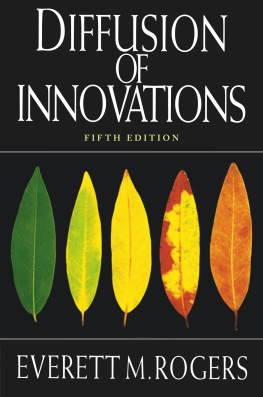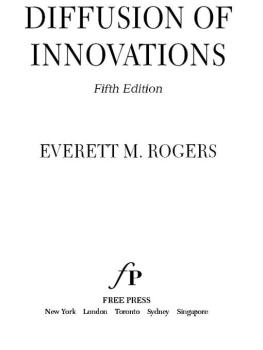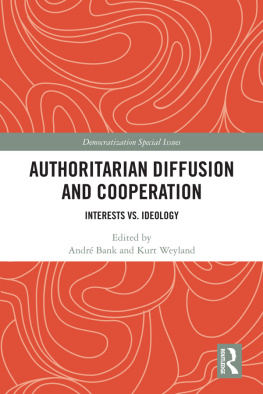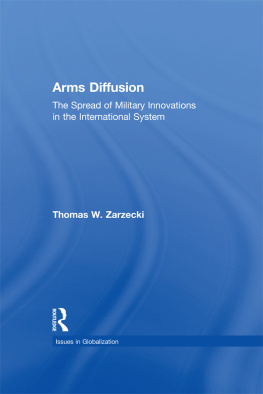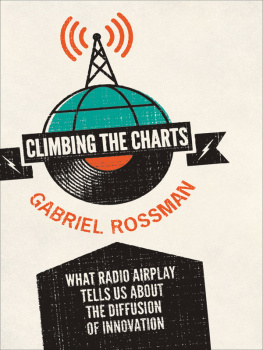Thank you for downloading this Free Press eBook.
Join our mailing list and get updates on new releases, deals, bonus content and other great books from Free Press and Simon & Schuster.
C LICK H ERE T O S IGN U P
or visit us online to sign up at
eBookNews.SimonandSchuster.com
We hope you enjoyed reading this Free Press eBook.
Join our mailing list and get updates on new releases, deals, bonus content and other great books from Free Press and Simon & Schuster.
C LICK H ERE T O S IGN U P
or visit us online to sign up at
eBookNews.SimonandSchuster.com

FREE PRESS
A Division of Simon & Schuster, Inc.
1230 Avenue of the Americas
New York, NY 10020
www.SimonandSchuster.com
Copyright 1995, 2003 by Everett M. Rogers
Copyright 1962, 1971, 1983 by The Free Press, A Division of Simon & Schuster, Inc.
All rights reserved, including the right of reproduction in whole or in part in any form.
This Free Press trade paperback edition 2003
FREE PRESS and colophon are trademarks of Simon & Schuster, Inc.
The first edition of this book, by Everett M. Rogers, was published as Diffusion of Innovations; the second edition, by Everett M. Rogers with F. Floyd Shoemaker, was published as Communication of Innovations: A Cross-Cultural Approach; the third edition, by Everett M. Rogers, was published as Diffusion of Innovations, as was the fourth edition.
Designed by Nancy Singer Olaguera
Library of Congress Cataloging-in-Publication Data
Rogers, Everett M.
Diffusion of innovations / Everett M. Rogers5th ed.
p. cm.
Includes bibliographical references and index.
1. Diffusion of innovations. 2. Diffusion of innovationsStudy and teachingHistory. I. Title.
HM621.R57 2003
303.48'4dc21
2003049022
ISBN 0-7432-2209-1
ISBN-13: 978-0-7432-5823-4 (eBook)
Dedicated to Bob Wallace, longtime editor of Free Press, who had faith in five editions of this book
Contents
PREFACE
This volume, the fifth edition of my book Diffusion of Innovations, builds on its predecessors by retaining the same basic diffusion model that originally appeared in the first edition in 1962. Over the past four decades, this general model of the diffusion of innovations has been modified somewhat and expanded, based on further research and on theoretical developments. What is new in the present edition of Diffusion of Innovations is (1) changes in the contributions of various diffusion traditions, with marketing, public health, and communication coming on particularly strong in recent years, (2) many studies of the diffusion of new communication technologies like the Internet and cellular telephones, (3) expanded understanding of diffusion networks through such concepts as the critical mass and individual thresholds, and (4) the use of field experiments (in addition to surveys) to test the effects of such diffusion interventions as using opinion leaders. Many of the case illustrations, and the figures that accompany certain of them, are new to this edition.
My introduction to research on the diffusion of innovations happened in the following manner. I became interested in the diffusion of agricultural innovations by observing farmers in my home community near Carroll, Iowa, who delayed for several years in adopting new ideas that could have been profitable for them. This behavior was puzzlingand frustratingto me. Why didnt farmers adopt innovations? Factors other than just economic explanations must have been at work.
I had graduated from Iowa State University with a bachelors degree in agriculture in 1952 and then served as an Air Force officer during the Korean War, when I learned the skills of applied social science research. After my discharge from military service, I returned to Iowa State for graduate work in rural sociology, to study the diffusion of agricultural innovations. At that time, Iowa State was one of the centers of diffusion research as a result of the hybrid seed corn study by Bryce Ryan and Neal C. Gross (1943).
In 1954, Professor George Beal at Iowa State University was initiating a diffusion project in one community, Collins, Iowa, located about twenty miles from Ames. This project was supported by the Iowa Agricultural Experiment Station, the research unit at Iowa State that had funded research to develop hybrid seed corn and other agricultural innovations. I joined Beals diffusion project in spring, 1954, and within about a week of my discharge from the Air Force, I was participating in a graduate seminar on diffusion, taught by Beal. I read the Ryan and Gross (1943) paper about the diffusion of hybrid seed corn in two Iowa communities. Shortly thereafter, I began interviewing some of the 148 farmers in Collins about their adoption of 2,4-D weed spray and other agricultural innovations. Thus I became a diffusion scholar.
My doctoral dissertation in 1957 was an analysis of the diffusion of several agricultural innovations in the rural community of Collins. While reviewing literature for my dissertation, I encountered studies of the diffusion of kindergartens and of driver training among schools (Mort, 1953), as well as the spread of an antibiotic drug (tetracycline) among medical doctors (Menzel and Katz, 1955). The main findings were strikingly similar to the agricultural diffusion studies in which I was involved: an S-shaped rate of adoption over time, different sources or channels at different stages in the innovation-decision process for an individual, and a tendency for innovators (the first individuals in a system to adopt an innovation) to travel and read widely and to have a cosmopolite orientation. The review of literature chapter in my dissertation argued that diffusion was a general process, not bound by the type of innovation studied, who the adopters were, or by place or culture. I was convinced that the diffusion of innovations was a kind of universal process of social change.
Certainly one event that encouraged this type of thinking was a presentation on the diffusion of agricultural innovations by Professors George Beal and Joe Bohlen to the staff of the Iowa Extension Service in December 1954 in Ames. This dramatic presentation had grown out of the graduate seminar on diffusion in which I had enrolled the previous spring at Iowa State and focused (1) on the sources or channels of communication used at stages in the individual-level innovation-decision process, and (2) on characteristics of farmers who adopted relatively earlier and relatively later in the diffusion process. These were important steps toward generalizing a model of diffusion, although the Beal/Bohlen conceptualization was mainly oriented to farm innovations. Soon, however, Beal and Bohlen were being asked to give their presentation to audiences interested in civil defense (where the innovation of interest was building household bomb shelters) and household consumer products. Clearly, a more general diffusion model was being discussed.
After completing graduate work at Iowa State in 1957, I joined the rural sociology faculty at Ohio State University, where I conducted research on the diffusion of agricultural innovations among Ohio farmers. My argument for a generalized diffusion model led me to write the first edition of Diffusion of Innovations, which was published in 1962. This book summarized diffusion research findings to date, organized around a general diffusion model, and argued for more standardized ways of adopter categorization and for conceptualizing the diffusion process. In 19631964, I taught and conducted research on the diffusion process in peasant communities in Colombia as a Fulbright lecturer. This experience allowed me to test the universality of the diffusion model, such as whether the diffusion of innovations also characterized peasant villages in developing countries, where the mass media were rare and where social change was often just getting under way.
Next page
